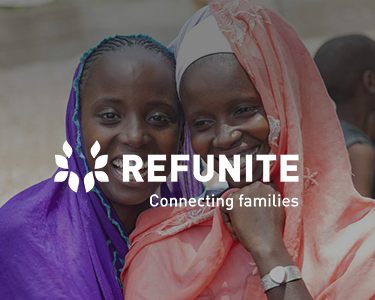
In this blog post, Nelson Okello, one of REFUNITE’s Back-End Developers, shares his thoughts on IVR and how it can be used to reconnect families.
Technological development has come a long way in the 21st century. However, a large percentage of the global population still has no access to computers let alone the internet. A report by the Telecommunication Development Sector (ITU) says only 40% of the world’s population use the internet.
 It might take another 10 years to realize universal internet access; although this is an optimistic guess. However, everything is not all gloomy. At present, we already have technologies that can bridge the gap; for example, GSM enables Short Messaging Services (SMS), Unstructured Supplementary Service Data (USSD) and Voice Messages which are not dependant on Internet access.
It might take another 10 years to realize universal internet access; although this is an optimistic guess. However, everything is not all gloomy. At present, we already have technologies that can bridge the gap; for example, GSM enables Short Messaging Services (SMS), Unstructured Supplementary Service Data (USSD) and Voice Messages which are not dependant on Internet access.
REFUNITE’s family reconnection platform can be accessed via the following touch points: Web, SMS and USSD. We are currently exploring how we can make the platform accessible using Interactive Voice Response. this would especially benefit users of REFUNITE who are unable to read.
There are several ways that user experience can be enhanced on REFUNITE’s platform: a video with step by step instructions on how to look for a long lost cousin; a game that teaches a user the virtues of helping a neighbour reconnect with her long lost uncle or real-time chat to assist users when they experience difficulties on the platform either while registering and/or confirming a successful reconnection.
The good news is that according to a recent study by Frost & Sullivan, the mobile phone penetration rate in Africa is expected to reach 79% by 2020. The phone subscription rate is at 72% in Kenya, 44% in Uganda, 42% in the Democratic Republic of Congo, 49% in Somalia and 56% in Syria according to a 2013 World Bank study. These are all countries where REFUNITE has a strong presence.
It is also true that smartphone penetration rates are rising fast. This is especially the case in the less developed countries of Africa, Asia and Latin America. But it’s also true that Internet infrastructure that would enable full utilization of these smartphones’ capabilities still lags behind in most of these regions. The net effect of this is that SMS, USSD and Voice continue to be the most widely available options.
For application developers, SMS and USSD have been well utilized and continue to be used in many innovative ways. Whereas voice has been used by the big corporations for automated attendants, it is a less leveraged option however due to the higher cost associated with it. This is in spite of the fact that voice calls can be made even from the most basic of phones. SMS and USSD are a great option for those who have at least basic reading and writing skills. However, refugees present a special scenario, whereby a large proportion of them cannot read or write because of a number of factors.
Almost everyone can talk, irrespective of their level of education. This could make voice the best possible option for applications targeting those with literacy challenges in the refugee camps and elsewhere. For a long time, big companies with corresponding budgets utilised automated attendants for customer care and sales campaigns. Extending these automated attendants to interact with “backend” applications is what is called Interactive Voice Response (IVR).
Back in the day when automated attendants were a reserve of the “selected few”, IVR was complex and a nightmare to implement. Implementing a basic automated attendant cost thousands of dollars. Those days are now long gone; open source has liberated many processes and systems at little or no cost to users. Today, implementing an IVR is akin to writing a basic scheduler application. In the paragraphs that follow, we will look at some scenarios in which IVR can be leveraged in refugee reconnection efforts.

In Juba, South Sudan, REFUNITE and the International Rescue Committee run a mobile outreach programme with volunteers. Let’s assume that each volunteer has been given a basic mobile phone; one that can make voice calls. Finally, let’s assume that the South Sudanese have access to a basic mobile phone but they don’t understand English, or any of the mainstream languages. Now, REFUNITE wishes to make it possible for these South Sudanese to create profiles on its platform. Can SMS or USSD handle this scenario?
YES! But only if these South Sudanese refugees have sufficient literacy level or have access to someone who does. In the event that they don’t, IVR would be a viable option and probably the only viable option. We can configure our IVR system such that when South Sudanese refugees make phone calls, their calls are routed to the volunteers who understand one of the major South Sudanese dialects. These volunteers can then interview them for required information and help them create a profile. Based on whether volunteers are in a position to write or not, the interview responses can be recorded for later transcription or entered into the system as the interview progresses.
Second, let’s extend our assumption a little further. In addition to assuming that there are South Sudanese refugees who do not know how to read and write, assume also that there is no South Sudanese language-speaking volunteer available to take their calls in real time. When a South Sudanese makes a call to the REFUNITE platform, interactive questions are presented to them in their language. Their responses are recorded for later transcription and validation. Provided the questionnaire are well designed and kept simple, this can be another way to improve family reconnection rates.
Third, let’s assume that our South Sudanese users have basic mobile phones but do not have calling credit or airtime. How can our IVR system help them create profiles for their missing loved ones or register themselves as refugees? Well, we can configure our system to capture missed calls. We would then inform our South Sudanese users to send us a missed calls at a designated number, then our agents or volunteers would return their calls when they become available, our agents would call them back and interview them to get the information required to create a profile.
Fourth, IVRs can be leveraged to send notifications. Assume the less obvious scenario where a user prefers to receive voice notifications as opposed to SMS or e-mail. This is analogous to a voicemail retrieval service. The user will be required to dial a certain number where his/her notifications will be read back to them. This is possible using text to speech conversion. Unlike speech to text conversion, text to speech conversion is a mature technology which is popular in many industries. Given that integrating IVR with “backend” applications is now a less arduous task, IVR presents a good alternative to interacting with REFUNITE’s platform for those who are unable to use SMS or USSD due to literacy or other challenges.
Next Step
How can we implement an IVR system which will allow us to actualise the scenarios outlined above?
At the core, an IVR is built on a Private Branch eXchange (PBX) system. PBX systems can be configured to use “old school” analogue telephone lines and modern day SIP phones. SIP (Session Initiation Protocol) is a communication protocol and is what Skype and WhatsApp use for voice calls. It is also possible to configure a PBX to accept and route GSM traffic. This makes it possible to assign a mobile telephone number to a PBX system through the use of a GSM Gateway. With this in place, a user can call a PBX system the same way she would call another person’s mobile phone.
When a user calls a number assigned to our IVR system, the system intercepts the call and, based on the callers’ telephone number, retrieves relevant information from the other applications to fulfil desired functions.
Implementing this does not require investment in a very expensive IVR system. There are mature open source PBX software that, with a little programming, can be used to create a highly robust and flexible IVR system. The only investment required would be in hardware like GSM gateway and a server to host the system and Internet bandwidth.
It is possible to use IVR as an option to interacting with the REFUNITE platform and I look forward to helping realize this and reconnecting many more families.
Connect with Okello on email: on@refunite.org or Twitter: @cnokello


